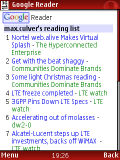Lately, I've had the opportunity to experiment a bit with a Samsung F480, also known as the Toco, one of Samsung's touch screen phones. At a price point of 300 euros without a contract one would expect it to be a smartphone, as devices such as the Nokia N78 are available for less these days. However, it is not. Instead, it's a classic mid-range phone with a touch screen, so a bit pricey for it's capabilities.
That said, however, I found the touch screen implementation to be very good, intuitive and easy to use. A well done device that will surely find it's customers. After having gotten used to the large screen and big icons, it takes a minute to adapting again to the comparatively small screen of the N78. Many people will feel the same when taking the decision in a shop for which phone to go so this is a big advantage for touch phones in general.
When I look around in the metro these days I see a lot of touch based phones and mobile devices in the hands of non-geeks. Quite a rapid adoption in less than a year. The F480's touch interface can be used with one hand only, something that I think is very useful in crowded places such as the metro.
I guess what many people find appealing about touch user interfaces apart from the bigger screen sizes is the missing indirection from what they see to what they press. You want to launch the calendar application, you simply click on it instead of using the D-pad at the other end of the phone to first scroll through the icon list to select it. It's straight forward.
So where is Nokia with touch phones these days? There is the Nokia 5800 but it is still not generally available in December 2008, so Samsung, LG and others have a considerable advantage for the moment. I guess it has something to do with Nokia implementing the touch interface in their high end S60 smart phone OS, i.e. the task takes considerably more time than for a mid-range phones with a limited amount of software on it. There's a good review by Rafe Blandford of the 5800 and he comes to a similar conclusion.
In addition, what makes a smartphone powerful is the number of third party applications. While most current applications will run on a touch enabled S60 device they can't take advantage of the touch based UI unless they are adapted. Take OperaMini for example which is strongly keypad/shortcut based. For efficient use on a touch device a separate touch version needs to be developed so zooming, scrolling and selecting commands and options works via the touch interface as well. Many software developers won't be too happy about developing yet one more version / input method.
The first N-series touched based device, the N97, is still at least 6 to 9 months out. That's a long time to wait. But it seems there are not many alternatives for me at this time. The iPhone is too restrictive, Windows Mobile based touch devices only seem to have a touch layer for use with fingers in the front with most applications in the back still being stylus based. And also, OperaMini is not yet touch based… Still too many obstacles for the moment.

